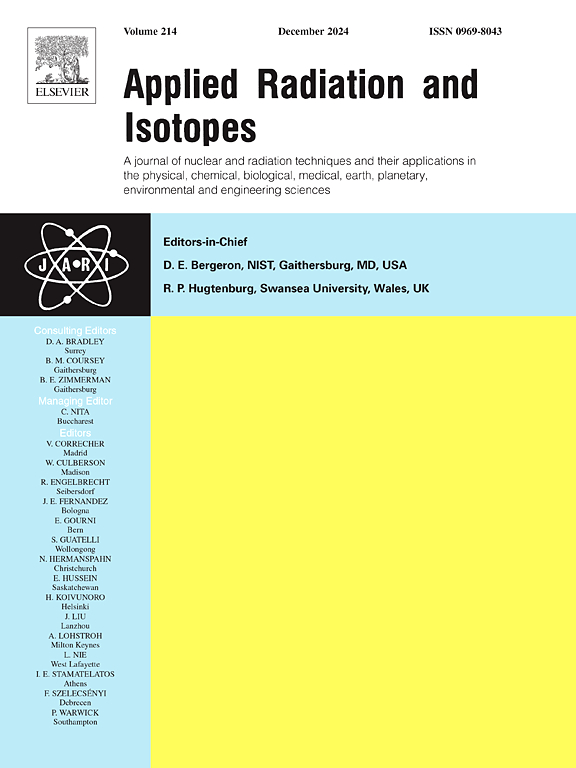Optimizing radiation dosimetry: Impact of PMMA layers on electronic equilibrium for the calibration of radiation protection instruments
IF 1.6
3区 工程技术
Q3 CHEMISTRY, INORGANIC & NUCLEAR
引用次数: 0
Abstract
In radiation dosimetry, achieving electronic equilibrium is vital for accurate dose measurements in radioprotection. This study investigates the effect of Poly Methyl Methacrylate (PMMA) layers, known by its chemical formula C5H8O2 and a density of 1.19 g/cm³ (PNNL, 2011), on electronic equilibrium for the calibration of radiation protection instruments, focusing on photon beams of varying energies. Using DOSIMEX 2.0 simulation software, we modeled the influence of PMMA thickness on calibration factors across different X-ray and gamma-ray beam energies. Experimental validation with Cs-137 and Co-60 sources confirmed the reliability of the simulation. Our results highlight that while PMMA layers have a minimal impact on calibration for higher-energy beams, their role becomes significant for energies below 40 keV. For X-ray beams (From 30 to 140 kV), the results show minimal calibration factor deviation (<1.6%), whereas radionuclide beams exhibit more significant variations (4.1%), necessitating customized calibration approaches. This study underscores the importance of adhering to ISO 4037-3 standards in radioprotection, particularly in low-energy scenarios, to ensure the precision of calibration procedures and optimize radiation protection practices. Furthermore, based on the results obtained, the absence of PMMA does not have a dramatic effect on the calibration of X-ray radiation instruments, whereas for gamma-ray beams, it has a significant impact.
优化辐射剂量测定:PMMA 层对辐射防护仪器校准电子平衡的影响。
在辐射剂量测定中,实现电子平衡对辐射防护中的精确剂量测量至关重要。本研究调查了聚甲基丙烯酸甲酯(PMMA)层(化学式为 C5H8O2,密度为 1.19 g/cm³(PNNL,2011 年))对辐射防护仪器校准电子平衡的影响,重点是不同能量的光子束。利用 DOSIMEX 2.0 仿真软件,我们模拟了 PMMA 厚度对不同 X 射线和伽马射线束能量下校准系数的影响。使用 Cs-137 和 Co-60 源进行的实验验证证实了模拟的可靠性。我们的结果表明,虽然 PMMA 层对较高能量光束的校准影响很小,但在能量低于 40 keV 时,它们的作用就变得非常重要。对于 X 射线束(从 30 到 140 kV),结果显示校准因子偏差最小 (
本文章由计算机程序翻译,如有差异,请以英文原文为准。
求助全文
约1分钟内获得全文
求助全文
来源期刊

Applied Radiation and Isotopes
工程技术-核科学技术
CiteScore
3.00
自引率
12.50%
发文量
406
审稿时长
13.5 months
期刊介绍:
Applied Radiation and Isotopes provides a high quality medium for the publication of substantial, original and scientific and technological papers on the development and peaceful application of nuclear, radiation and radionuclide techniques in chemistry, physics, biochemistry, biology, medicine, security, engineering and in the earth, planetary and environmental sciences, all including dosimetry. Nuclear techniques are defined in the broadest sense and both experimental and theoretical papers are welcome. They include the development and use of α- and β-particles, X-rays and γ-rays, neutrons and other nuclear particles and radiations from all sources, including radionuclides, synchrotron sources, cyclotrons and reactors and from the natural environment.
The journal aims to publish papers with significance to an international audience, containing substantial novelty and scientific impact. The Editors reserve the rights to reject, with or without external review, papers that do not meet these criteria.
Papers dealing with radiation processing, i.e., where radiation is used to bring about a biological, chemical or physical change in a material, should be directed to our sister journal Radiation Physics and Chemistry.
 求助内容:
求助内容: 应助结果提醒方式:
应助结果提醒方式:


